Analyzing Human Resource Management in a Global Economy Context
VerifiedAdded on 2023/06/13
|12
|3713
|295
Report
AI Summary
This report provides an overview of human resource management activities in a global environment, addressing challenges such as diversity management, cross-cultural issues, international performance management, and training and development. It discusses the importance of diversity in the workplace and the potential challenges organizations face in managing it, including discrimination and cultural shock. The report also examines international performance management, highlighting the need for differential policies based on location and the impact of performance appraisal systems on employee motivation. Furthermore, it emphasizes the significance of training and development in equipping employees with the necessary skills and knowledge. The analysis incorporates the resource-based theory of diversity management and Hofstede's cultural dimensions to provide a comprehensive understanding of the complexities involved in managing human resources in a global context, using the case study of ‘No Name’ aircrafts to illustrate practical challenges and recommendations for improvement. Desklib provides access to this and other solved assignments.
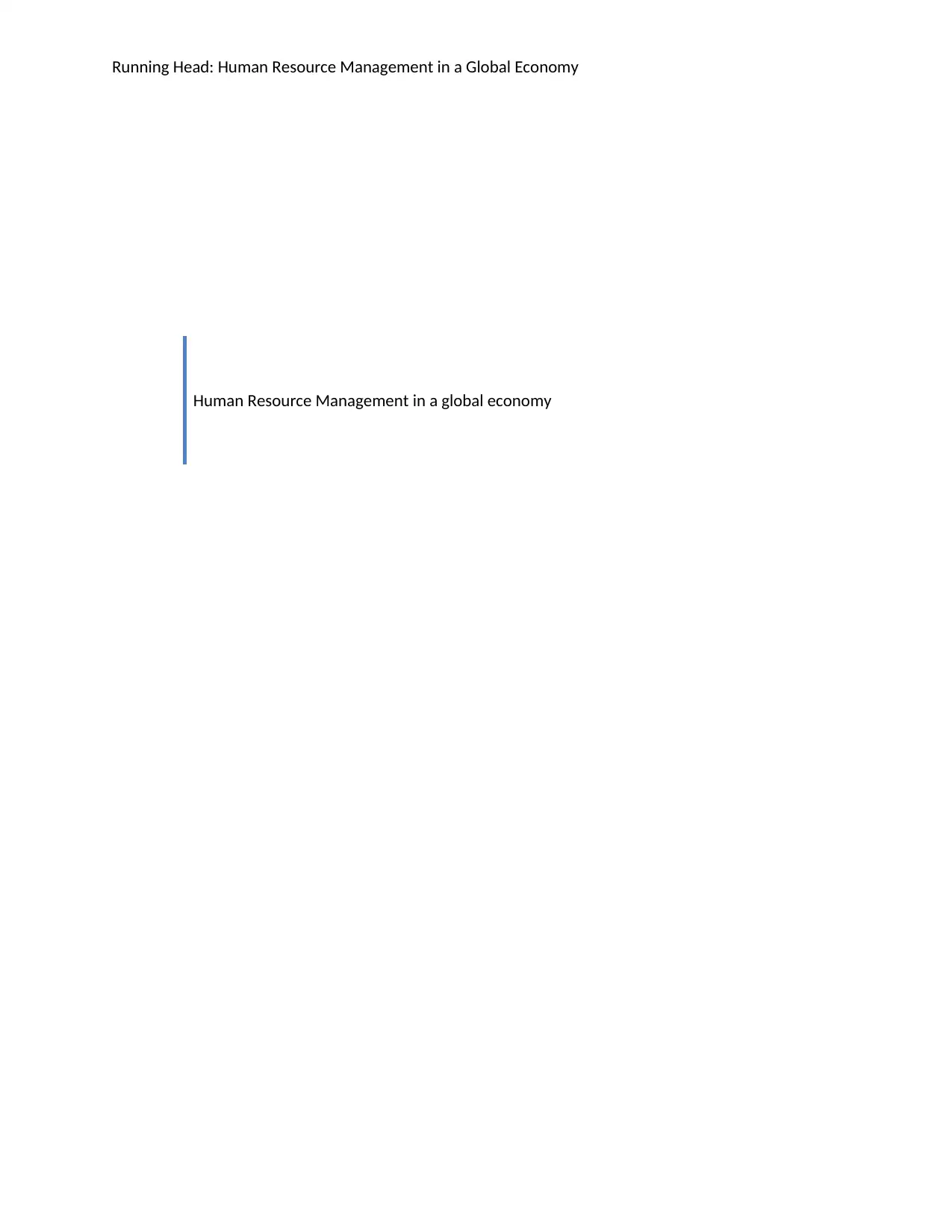
Running Head: Human Resource Management in a Global Economy
Human Resource Management in a global economy
Human Resource Management in a global economy
Paraphrase This Document
Need a fresh take? Get an instant paraphrase of this document with our AI Paraphraser
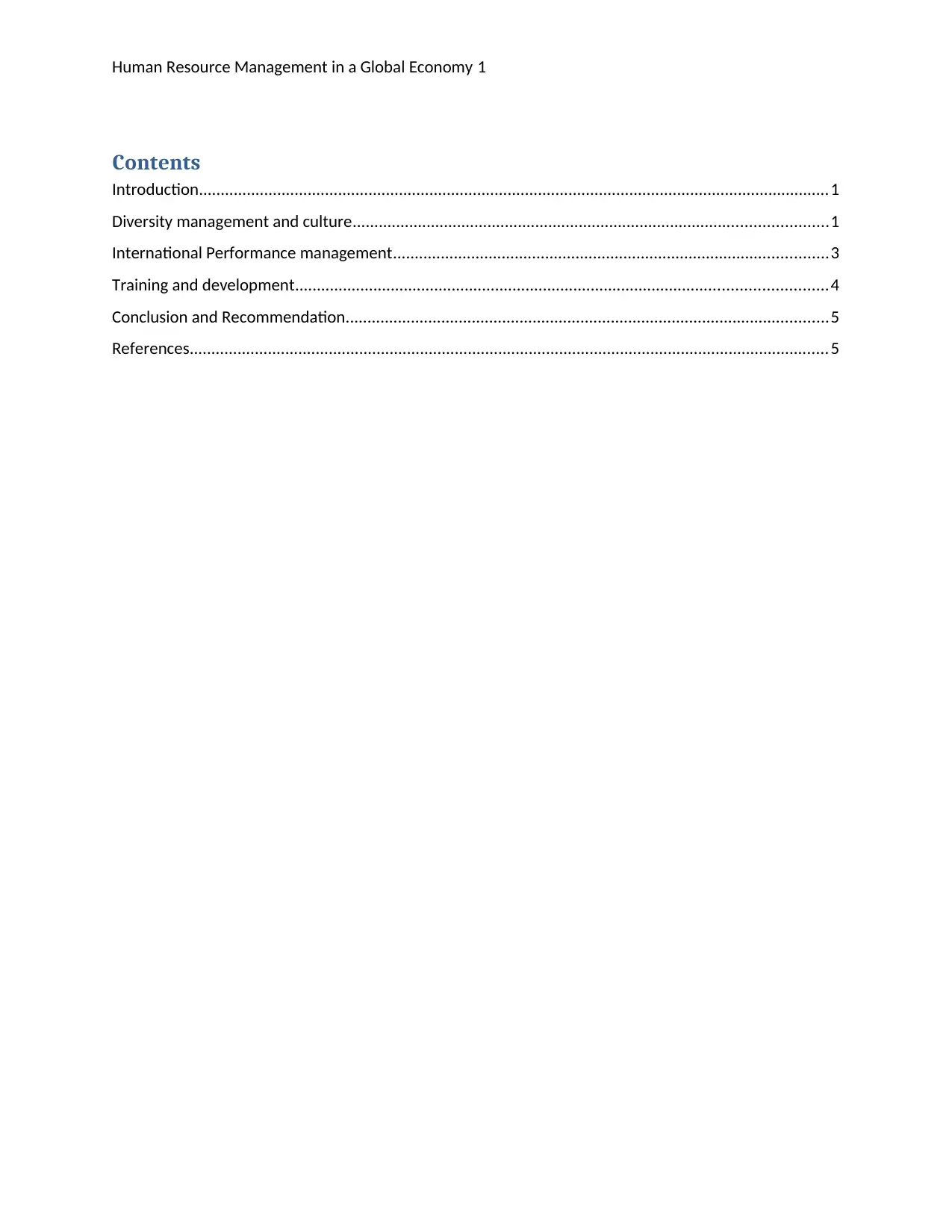
Human Resource Management in a Global Economy 1
Contents
Introduction.................................................................................................................................................1
Diversity management and culture.............................................................................................................1
International Performance management....................................................................................................3
Training and development..........................................................................................................................4
Conclusion and Recommendation...............................................................................................................5
References...................................................................................................................................................5
Contents
Introduction.................................................................................................................................................1
Diversity management and culture.............................................................................................................1
International Performance management....................................................................................................3
Training and development..........................................................................................................................4
Conclusion and Recommendation...............................................................................................................5
References...................................................................................................................................................5
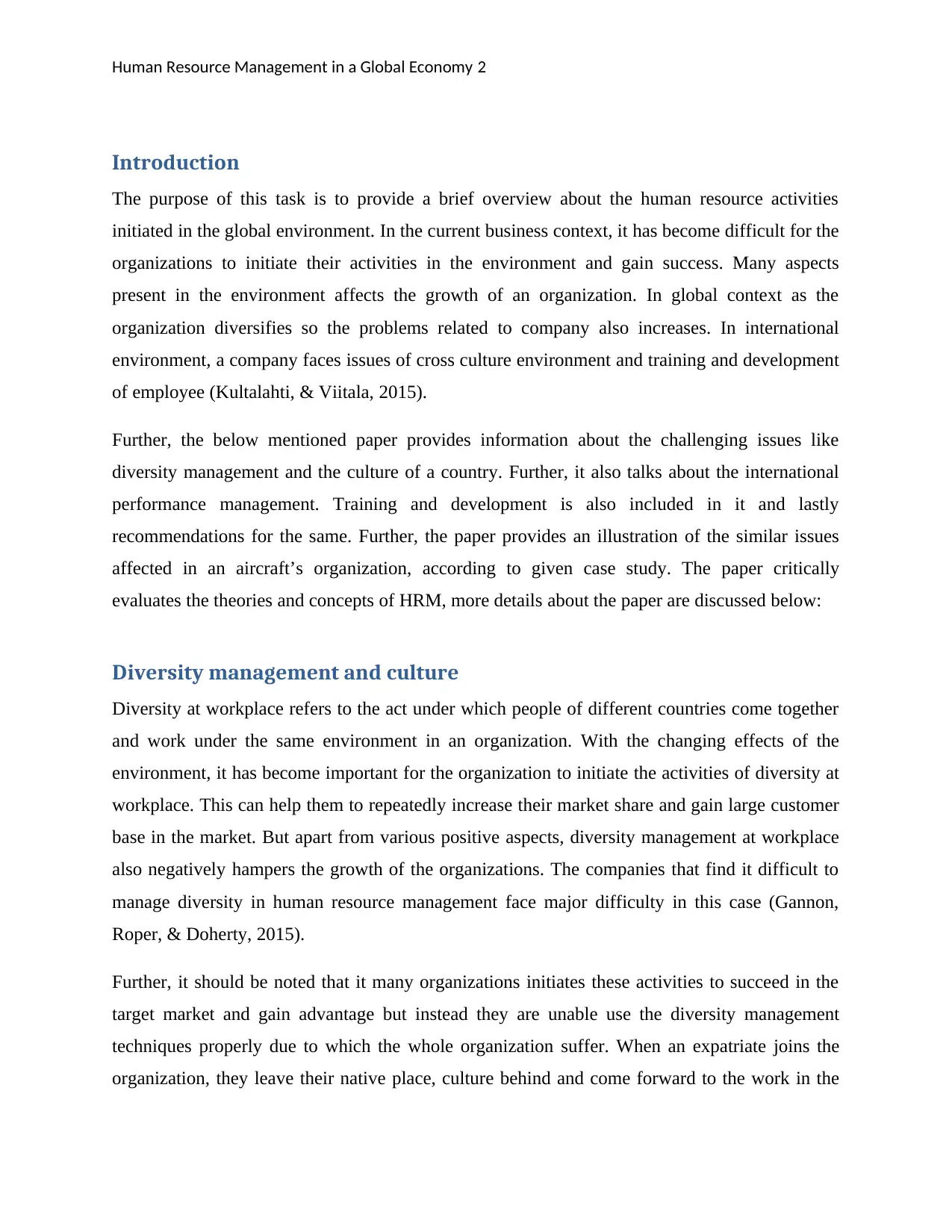
Human Resource Management in a Global Economy 2
Introduction
The purpose of this task is to provide a brief overview about the human resource activities
initiated in the global environment. In the current business context, it has become difficult for the
organizations to initiate their activities in the environment and gain success. Many aspects
present in the environment affects the growth of an organization. In global context as the
organization diversifies so the problems related to company also increases. In international
environment, a company faces issues of cross culture environment and training and development
of employee (Kultalahti, & Viitala, 2015).
Further, the below mentioned paper provides information about the challenging issues like
diversity management and the culture of a country. Further, it also talks about the international
performance management. Training and development is also included in it and lastly
recommendations for the same. Further, the paper provides an illustration of the similar issues
affected in an aircraft’s organization, according to given case study. The paper critically
evaluates the theories and concepts of HRM, more details about the paper are discussed below:
Diversity management and culture
Diversity at workplace refers to the act under which people of different countries come together
and work under the same environment in an organization. With the changing effects of the
environment, it has become important for the organization to initiate the activities of diversity at
workplace. This can help them to repeatedly increase their market share and gain large customer
base in the market. But apart from various positive aspects, diversity management at workplace
also negatively hampers the growth of the organizations. The companies that find it difficult to
manage diversity in human resource management face major difficulty in this case (Gannon,
Roper, & Doherty, 2015).
Further, it should be noted that it many organizations initiates these activities to succeed in the
target market and gain advantage but instead they are unable use the diversity management
techniques properly due to which the whole organization suffer. When an expatriate joins the
organization, they leave their native place, culture behind and come forward to the work in the
Introduction
The purpose of this task is to provide a brief overview about the human resource activities
initiated in the global environment. In the current business context, it has become difficult for the
organizations to initiate their activities in the environment and gain success. Many aspects
present in the environment affects the growth of an organization. In global context as the
organization diversifies so the problems related to company also increases. In international
environment, a company faces issues of cross culture environment and training and development
of employee (Kultalahti, & Viitala, 2015).
Further, the below mentioned paper provides information about the challenging issues like
diversity management and the culture of a country. Further, it also talks about the international
performance management. Training and development is also included in it and lastly
recommendations for the same. Further, the paper provides an illustration of the similar issues
affected in an aircraft’s organization, according to given case study. The paper critically
evaluates the theories and concepts of HRM, more details about the paper are discussed below:
Diversity management and culture
Diversity at workplace refers to the act under which people of different countries come together
and work under the same environment in an organization. With the changing effects of the
environment, it has become important for the organization to initiate the activities of diversity at
workplace. This can help them to repeatedly increase their market share and gain large customer
base in the market. But apart from various positive aspects, diversity management at workplace
also negatively hampers the growth of the organizations. The companies that find it difficult to
manage diversity in human resource management face major difficulty in this case (Gannon,
Roper, & Doherty, 2015).
Further, it should be noted that it many organizations initiates these activities to succeed in the
target market and gain advantage but instead they are unable use the diversity management
techniques properly due to which the whole organization suffer. When an expatriate joins the
organization, they leave their native place, culture behind and come forward to the work in the
⊘ This is a preview!⊘
Do you want full access?
Subscribe today to unlock all pages.

Trusted by 1+ million students worldwide
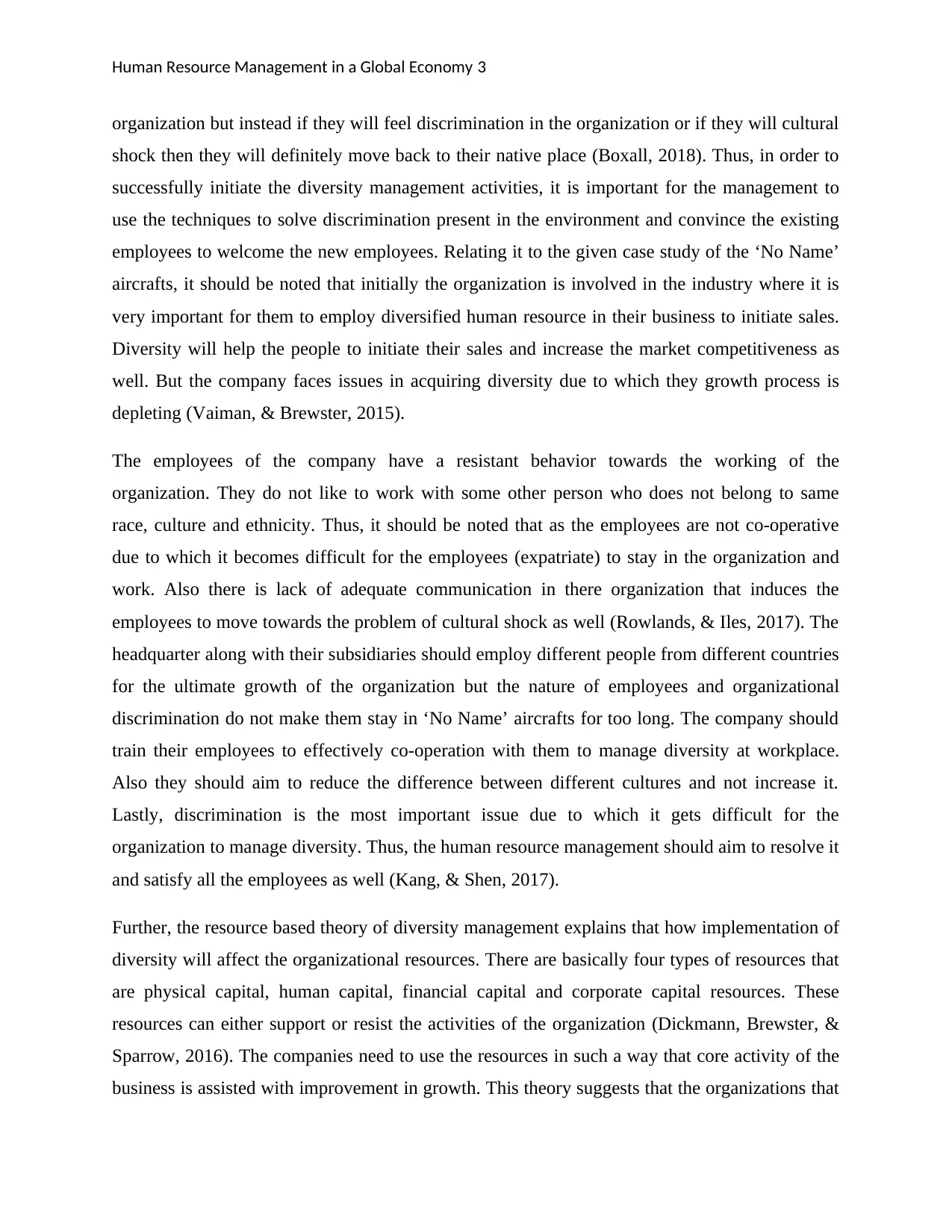
Human Resource Management in a Global Economy 3
organization but instead if they will feel discrimination in the organization or if they will cultural
shock then they will definitely move back to their native place (Boxall, 2018). Thus, in order to
successfully initiate the diversity management activities, it is important for the management to
use the techniques to solve discrimination present in the environment and convince the existing
employees to welcome the new employees. Relating it to the given case study of the ‘No Name’
aircrafts, it should be noted that initially the organization is involved in the industry where it is
very important for them to employ diversified human resource in their business to initiate sales.
Diversity will help the people to initiate their sales and increase the market competitiveness as
well. But the company faces issues in acquiring diversity due to which they growth process is
depleting (Vaiman, & Brewster, 2015).
The employees of the company have a resistant behavior towards the working of the
organization. They do not like to work with some other person who does not belong to same
race, culture and ethnicity. Thus, it should be noted that as the employees are not co-operative
due to which it becomes difficult for the employees (expatriate) to stay in the organization and
work. Also there is lack of adequate communication in there organization that induces the
employees to move towards the problem of cultural shock as well (Rowlands, & Iles, 2017). The
headquarter along with their subsidiaries should employ different people from different countries
for the ultimate growth of the organization but the nature of employees and organizational
discrimination do not make them stay in ‘No Name’ aircrafts for too long. The company should
train their employees to effectively co-operation with them to manage diversity at workplace.
Also they should aim to reduce the difference between different cultures and not increase it.
Lastly, discrimination is the most important issue due to which it gets difficult for the
organization to manage diversity. Thus, the human resource management should aim to resolve it
and satisfy all the employees as well (Kang, & Shen, 2017).
Further, the resource based theory of diversity management explains that how implementation of
diversity will affect the organizational resources. There are basically four types of resources that
are physical capital, human capital, financial capital and corporate capital resources. These
resources can either support or resist the activities of the organization (Dickmann, Brewster, &
Sparrow, 2016). The companies need to use the resources in such a way that core activity of the
business is assisted with improvement in growth. This theory suggests that the organizations that
organization but instead if they will feel discrimination in the organization or if they will cultural
shock then they will definitely move back to their native place (Boxall, 2018). Thus, in order to
successfully initiate the diversity management activities, it is important for the management to
use the techniques to solve discrimination present in the environment and convince the existing
employees to welcome the new employees. Relating it to the given case study of the ‘No Name’
aircrafts, it should be noted that initially the organization is involved in the industry where it is
very important for them to employ diversified human resource in their business to initiate sales.
Diversity will help the people to initiate their sales and increase the market competitiveness as
well. But the company faces issues in acquiring diversity due to which they growth process is
depleting (Vaiman, & Brewster, 2015).
The employees of the company have a resistant behavior towards the working of the
organization. They do not like to work with some other person who does not belong to same
race, culture and ethnicity. Thus, it should be noted that as the employees are not co-operative
due to which it becomes difficult for the employees (expatriate) to stay in the organization and
work. Also there is lack of adequate communication in there organization that induces the
employees to move towards the problem of cultural shock as well (Rowlands, & Iles, 2017). The
headquarter along with their subsidiaries should employ different people from different countries
for the ultimate growth of the organization but the nature of employees and organizational
discrimination do not make them stay in ‘No Name’ aircrafts for too long. The company should
train their employees to effectively co-operation with them to manage diversity at workplace.
Also they should aim to reduce the difference between different cultures and not increase it.
Lastly, discrimination is the most important issue due to which it gets difficult for the
organization to manage diversity. Thus, the human resource management should aim to resolve it
and satisfy all the employees as well (Kang, & Shen, 2017).
Further, the resource based theory of diversity management explains that how implementation of
diversity will affect the organizational resources. There are basically four types of resources that
are physical capital, human capital, financial capital and corporate capital resources. These
resources can either support or resist the activities of the organization (Dickmann, Brewster, &
Sparrow, 2016). The companies need to use the resources in such a way that core activity of the
business is assisted with improvement in growth. This theory suggests that the organizations that
Paraphrase This Document
Need a fresh take? Get an instant paraphrase of this document with our AI Paraphraser
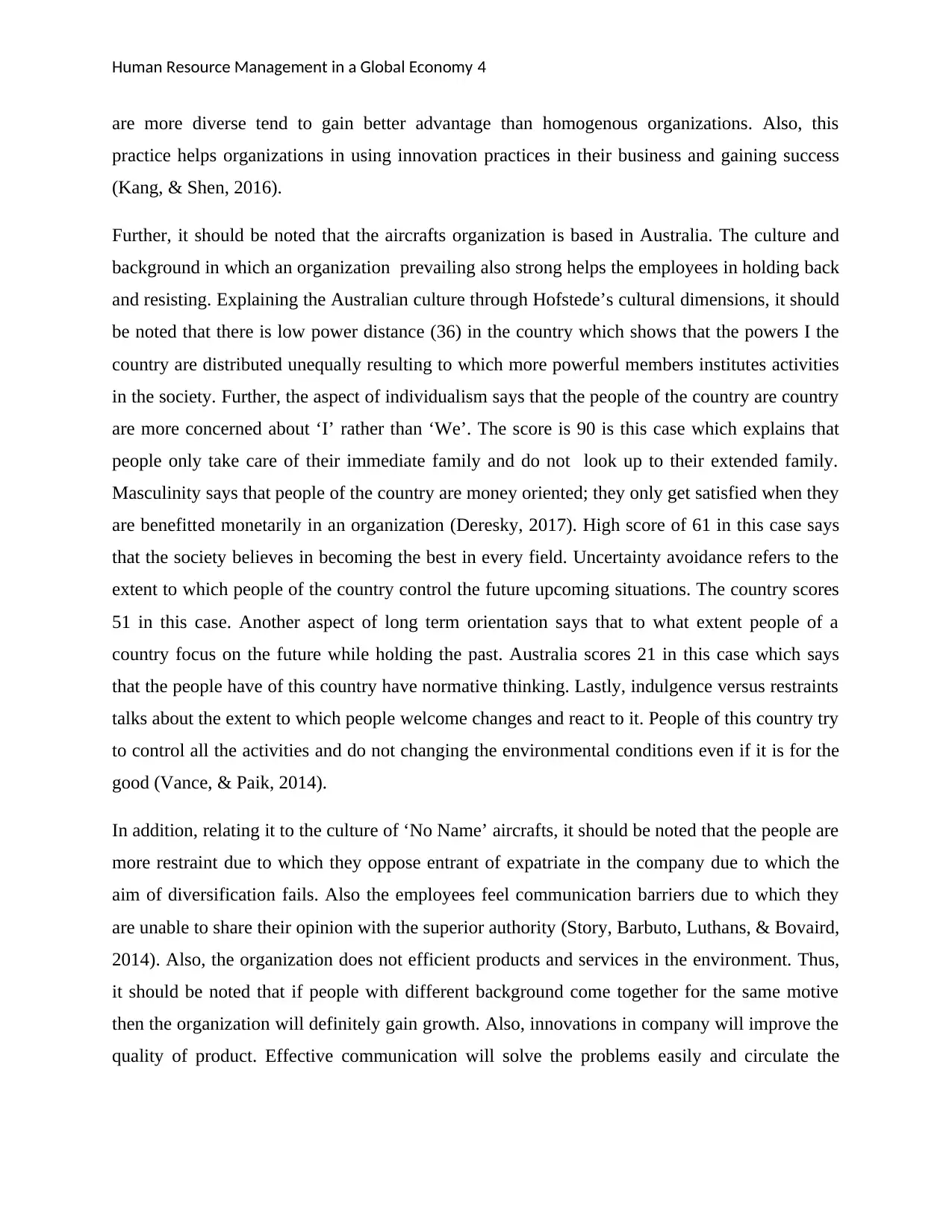
Human Resource Management in a Global Economy 4
are more diverse tend to gain better advantage than homogenous organizations. Also, this
practice helps organizations in using innovation practices in their business and gaining success
(Kang, & Shen, 2016).
Further, it should be noted that the aircrafts organization is based in Australia. The culture and
background in which an organization prevailing also strong helps the employees in holding back
and resisting. Explaining the Australian culture through Hofstede’s cultural dimensions, it should
be noted that there is low power distance (36) in the country which shows that the powers I the
country are distributed unequally resulting to which more powerful members institutes activities
in the society. Further, the aspect of individualism says that the people of the country are country
are more concerned about ‘I’ rather than ‘We’. The score is 90 is this case which explains that
people only take care of their immediate family and do not look up to their extended family.
Masculinity says that people of the country are money oriented; they only get satisfied when they
are benefitted monetarily in an organization (Deresky, 2017). High score of 61 in this case says
that the society believes in becoming the best in every field. Uncertainty avoidance refers to the
extent to which people of the country control the future upcoming situations. The country scores
51 in this case. Another aspect of long term orientation says that to what extent people of a
country focus on the future while holding the past. Australia scores 21 in this case which says
that the people have of this country have normative thinking. Lastly, indulgence versus restraints
talks about the extent to which people welcome changes and react to it. People of this country try
to control all the activities and do not changing the environmental conditions even if it is for the
good (Vance, & Paik, 2014).
In addition, relating it to the culture of ‘No Name’ aircrafts, it should be noted that the people are
more restraint due to which they oppose entrant of expatriate in the company due to which the
aim of diversification fails. Also the employees feel communication barriers due to which they
are unable to share their opinion with the superior authority (Story, Barbuto, Luthans, & Bovaird,
2014). Also, the organization does not efficient products and services in the environment. Thus,
it should be noted that if people with different background come together for the same motive
then the organization will definitely gain growth. Also, innovations in company will improve the
quality of product. Effective communication will solve the problems easily and circulate the
are more diverse tend to gain better advantage than homogenous organizations. Also, this
practice helps organizations in using innovation practices in their business and gaining success
(Kang, & Shen, 2016).
Further, it should be noted that the aircrafts organization is based in Australia. The culture and
background in which an organization prevailing also strong helps the employees in holding back
and resisting. Explaining the Australian culture through Hofstede’s cultural dimensions, it should
be noted that there is low power distance (36) in the country which shows that the powers I the
country are distributed unequally resulting to which more powerful members institutes activities
in the society. Further, the aspect of individualism says that the people of the country are country
are more concerned about ‘I’ rather than ‘We’. The score is 90 is this case which explains that
people only take care of their immediate family and do not look up to their extended family.
Masculinity says that people of the country are money oriented; they only get satisfied when they
are benefitted monetarily in an organization (Deresky, 2017). High score of 61 in this case says
that the society believes in becoming the best in every field. Uncertainty avoidance refers to the
extent to which people of the country control the future upcoming situations. The country scores
51 in this case. Another aspect of long term orientation says that to what extent people of a
country focus on the future while holding the past. Australia scores 21 in this case which says
that the people have of this country have normative thinking. Lastly, indulgence versus restraints
talks about the extent to which people welcome changes and react to it. People of this country try
to control all the activities and do not changing the environmental conditions even if it is for the
good (Vance, & Paik, 2014).
In addition, relating it to the culture of ‘No Name’ aircrafts, it should be noted that the people are
more restraint due to which they oppose entrant of expatriate in the company due to which the
aim of diversification fails. Also the employees feel communication barriers due to which they
are unable to share their opinion with the superior authority (Story, Barbuto, Luthans, & Bovaird,
2014). Also, the organization does not efficient products and services in the environment. Thus,
it should be noted that if people with different background come together for the same motive
then the organization will definitely gain growth. Also, innovations in company will improve the
quality of product. Effective communication will solve the problems easily and circulate the
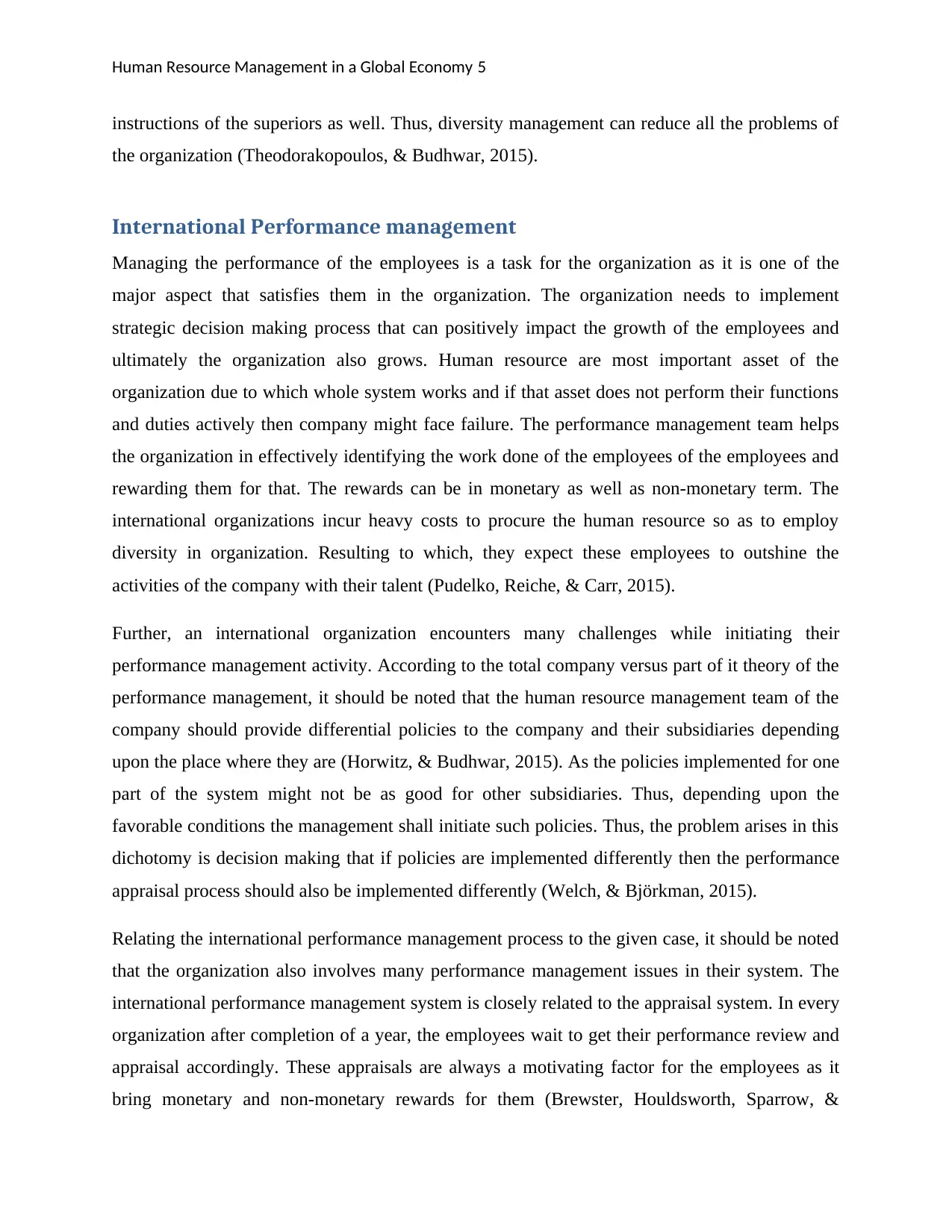
Human Resource Management in a Global Economy 5
instructions of the superiors as well. Thus, diversity management can reduce all the problems of
the organization (Theodorakopoulos, & Budhwar, 2015).
International Performance management
Managing the performance of the employees is a task for the organization as it is one of the
major aspect that satisfies them in the organization. The organization needs to implement
strategic decision making process that can positively impact the growth of the employees and
ultimately the organization also grows. Human resource are most important asset of the
organization due to which whole system works and if that asset does not perform their functions
and duties actively then company might face failure. The performance management team helps
the organization in effectively identifying the work done of the employees of the employees and
rewarding them for that. The rewards can be in monetary as well as non-monetary term. The
international organizations incur heavy costs to procure the human resource so as to employ
diversity in organization. Resulting to which, they expect these employees to outshine the
activities of the company with their talent (Pudelko, Reiche, & Carr, 2015).
Further, an international organization encounters many challenges while initiating their
performance management activity. According to the total company versus part of it theory of the
performance management, it should be noted that the human resource management team of the
company should provide differential policies to the company and their subsidiaries depending
upon the place where they are (Horwitz, & Budhwar, 2015). As the policies implemented for one
part of the system might not be as good for other subsidiaries. Thus, depending upon the
favorable conditions the management shall initiate such policies. Thus, the problem arises in this
dichotomy is decision making that if policies are implemented differently then the performance
appraisal process should also be implemented differently (Welch, & Björkman, 2015).
Relating the international performance management process to the given case, it should be noted
that the organization also involves many performance management issues in their system. The
international performance management system is closely related to the appraisal system. In every
organization after completion of a year, the employees wait to get their performance review and
appraisal accordingly. These appraisals are always a motivating factor for the employees as it
bring monetary and non-monetary rewards for them (Brewster, Houldsworth, Sparrow, &
instructions of the superiors as well. Thus, diversity management can reduce all the problems of
the organization (Theodorakopoulos, & Budhwar, 2015).
International Performance management
Managing the performance of the employees is a task for the organization as it is one of the
major aspect that satisfies them in the organization. The organization needs to implement
strategic decision making process that can positively impact the growth of the employees and
ultimately the organization also grows. Human resource are most important asset of the
organization due to which whole system works and if that asset does not perform their functions
and duties actively then company might face failure. The performance management team helps
the organization in effectively identifying the work done of the employees of the employees and
rewarding them for that. The rewards can be in monetary as well as non-monetary term. The
international organizations incur heavy costs to procure the human resource so as to employ
diversity in organization. Resulting to which, they expect these employees to outshine the
activities of the company with their talent (Pudelko, Reiche, & Carr, 2015).
Further, an international organization encounters many challenges while initiating their
performance management activity. According to the total company versus part of it theory of the
performance management, it should be noted that the human resource management team of the
company should provide differential policies to the company and their subsidiaries depending
upon the place where they are (Horwitz, & Budhwar, 2015). As the policies implemented for one
part of the system might not be as good for other subsidiaries. Thus, depending upon the
favorable conditions the management shall initiate such policies. Thus, the problem arises in this
dichotomy is decision making that if policies are implemented differently then the performance
appraisal process should also be implemented differently (Welch, & Björkman, 2015).
Relating the international performance management process to the given case, it should be noted
that the organization also involves many performance management issues in their system. The
international performance management system is closely related to the appraisal system. In every
organization after completion of a year, the employees wait to get their performance review and
appraisal accordingly. These appraisals are always a motivating factor for the employees as it
bring monetary and non-monetary rewards for them (Brewster, Houldsworth, Sparrow, &
⊘ This is a preview!⊘
Do you want full access?
Subscribe today to unlock all pages.

Trusted by 1+ million students worldwide
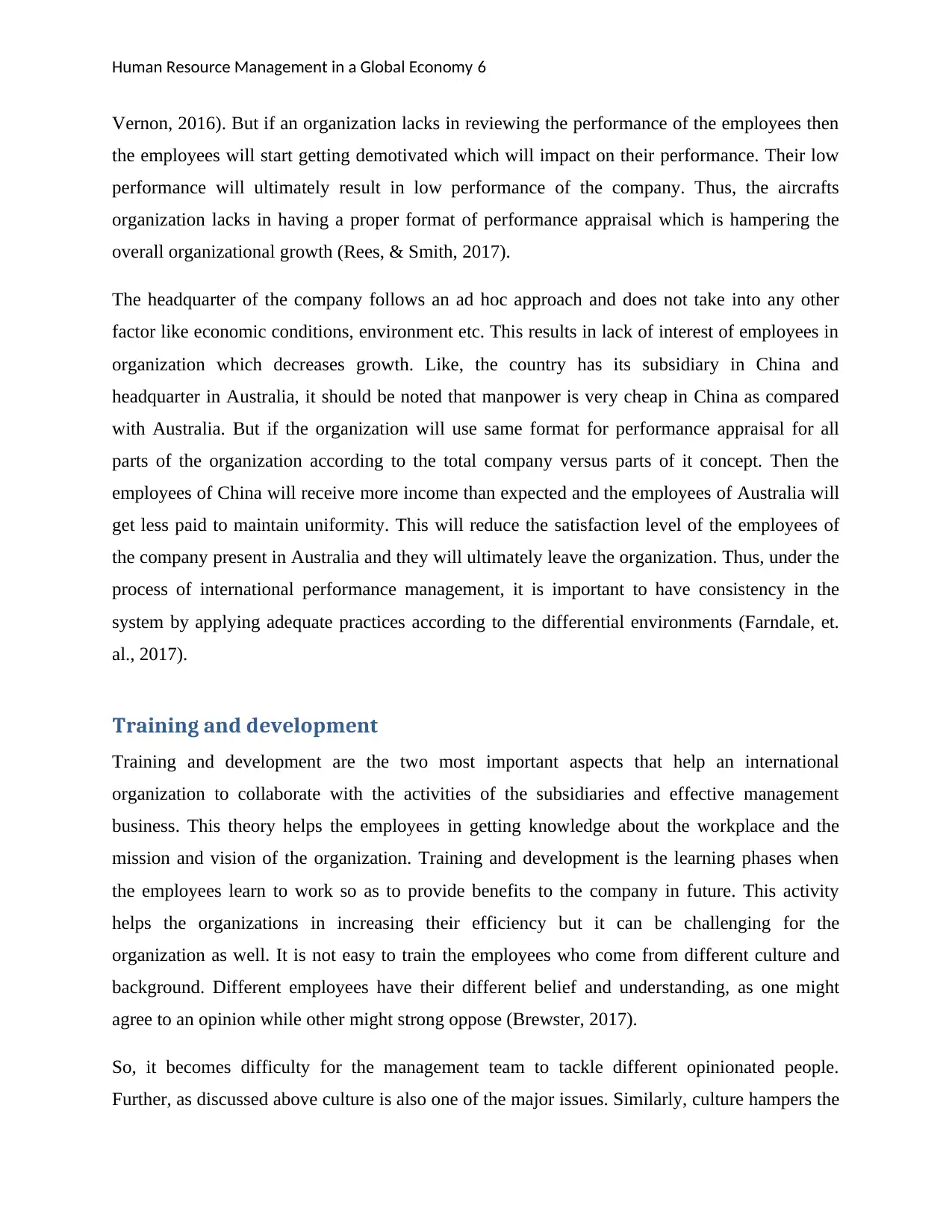
Human Resource Management in a Global Economy 6
Vernon, 2016). But if an organization lacks in reviewing the performance of the employees then
the employees will start getting demotivated which will impact on their performance. Their low
performance will ultimately result in low performance of the company. Thus, the aircrafts
organization lacks in having a proper format of performance appraisal which is hampering the
overall organizational growth (Rees, & Smith, 2017).
The headquarter of the company follows an ad hoc approach and does not take into any other
factor like economic conditions, environment etc. This results in lack of interest of employees in
organization which decreases growth. Like, the country has its subsidiary in China and
headquarter in Australia, it should be noted that manpower is very cheap in China as compared
with Australia. But if the organization will use same format for performance appraisal for all
parts of the organization according to the total company versus parts of it concept. Then the
employees of China will receive more income than expected and the employees of Australia will
get less paid to maintain uniformity. This will reduce the satisfaction level of the employees of
the company present in Australia and they will ultimately leave the organization. Thus, under the
process of international performance management, it is important to have consistency in the
system by applying adequate practices according to the differential environments (Farndale, et.
al., 2017).
Training and development
Training and development are the two most important aspects that help an international
organization to collaborate with the activities of the subsidiaries and effective management
business. This theory helps the employees in getting knowledge about the workplace and the
mission and vision of the organization. Training and development is the learning phases when
the employees learn to work so as to provide benefits to the company in future. This activity
helps the organizations in increasing their efficiency but it can be challenging for the
organization as well. It is not easy to train the employees who come from different culture and
background. Different employees have their different belief and understanding, as one might
agree to an opinion while other might strong oppose (Brewster, 2017).
So, it becomes difficulty for the management team to tackle different opinionated people.
Further, as discussed above culture is also one of the major issues. Similarly, culture hampers the
Vernon, 2016). But if an organization lacks in reviewing the performance of the employees then
the employees will start getting demotivated which will impact on their performance. Their low
performance will ultimately result in low performance of the company. Thus, the aircrafts
organization lacks in having a proper format of performance appraisal which is hampering the
overall organizational growth (Rees, & Smith, 2017).
The headquarter of the company follows an ad hoc approach and does not take into any other
factor like economic conditions, environment etc. This results in lack of interest of employees in
organization which decreases growth. Like, the country has its subsidiary in China and
headquarter in Australia, it should be noted that manpower is very cheap in China as compared
with Australia. But if the organization will use same format for performance appraisal for all
parts of the organization according to the total company versus parts of it concept. Then the
employees of China will receive more income than expected and the employees of Australia will
get less paid to maintain uniformity. This will reduce the satisfaction level of the employees of
the company present in Australia and they will ultimately leave the organization. Thus, under the
process of international performance management, it is important to have consistency in the
system by applying adequate practices according to the differential environments (Farndale, et.
al., 2017).
Training and development
Training and development are the two most important aspects that help an international
organization to collaborate with the activities of the subsidiaries and effective management
business. This theory helps the employees in getting knowledge about the workplace and the
mission and vision of the organization. Training and development is the learning phases when
the employees learn to work so as to provide benefits to the company in future. This activity
helps the organizations in increasing their efficiency but it can be challenging for the
organization as well. It is not easy to train the employees who come from different culture and
background. Different employees have their different belief and understanding, as one might
agree to an opinion while other might strong oppose (Brewster, 2017).
So, it becomes difficulty for the management team to tackle different opinionated people.
Further, as discussed above culture is also one of the major issues. Similarly, culture hampers the
Paraphrase This Document
Need a fresh take? Get an instant paraphrase of this document with our AI Paraphraser
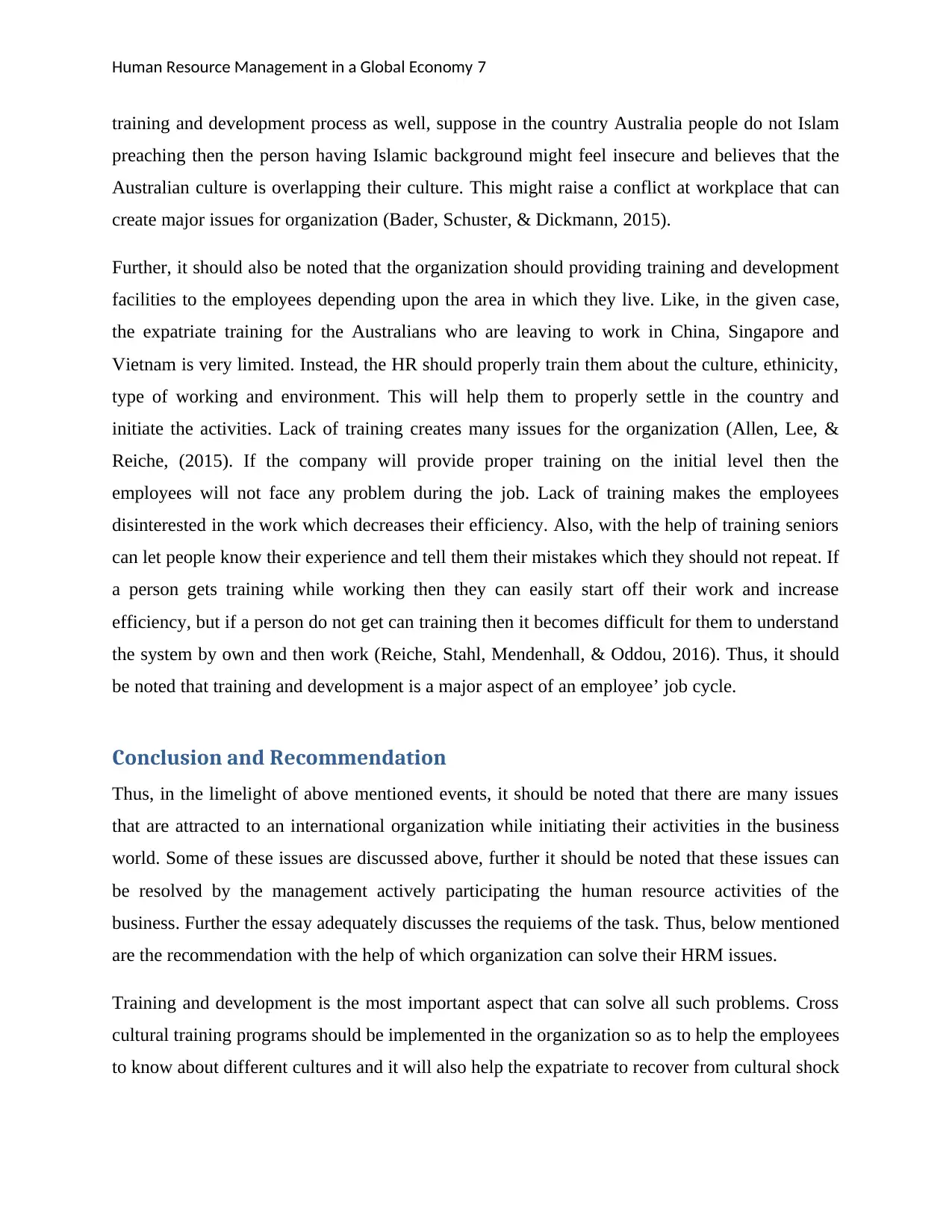
Human Resource Management in a Global Economy 7
training and development process as well, suppose in the country Australia people do not Islam
preaching then the person having Islamic background might feel insecure and believes that the
Australian culture is overlapping their culture. This might raise a conflict at workplace that can
create major issues for organization (Bader, Schuster, & Dickmann, 2015).
Further, it should also be noted that the organization should providing training and development
facilities to the employees depending upon the area in which they live. Like, in the given case,
the expatriate training for the Australians who are leaving to work in China, Singapore and
Vietnam is very limited. Instead, the HR should properly train them about the culture, ethinicity,
type of working and environment. This will help them to properly settle in the country and
initiate the activities. Lack of training creates many issues for the organization (Allen, Lee, &
Reiche, (2015). If the company will provide proper training on the initial level then the
employees will not face any problem during the job. Lack of training makes the employees
disinterested in the work which decreases their efficiency. Also, with the help of training seniors
can let people know their experience and tell them their mistakes which they should not repeat. If
a person gets training while working then they can easily start off their work and increase
efficiency, but if a person do not get can training then it becomes difficult for them to understand
the system by own and then work (Reiche, Stahl, Mendenhall, & Oddou, 2016). Thus, it should
be noted that training and development is a major aspect of an employee’ job cycle.
Conclusion and Recommendation
Thus, in the limelight of above mentioned events, it should be noted that there are many issues
that are attracted to an international organization while initiating their activities in the business
world. Some of these issues are discussed above, further it should be noted that these issues can
be resolved by the management actively participating the human resource activities of the
business. Further the essay adequately discusses the requiems of the task. Thus, below mentioned
are the recommendation with the help of which organization can solve their HRM issues.
Training and development is the most important aspect that can solve all such problems. Cross
cultural training programs should be implemented in the organization so as to help the employees
to know about different cultures and it will also help the expatriate to recover from cultural shock
training and development process as well, suppose in the country Australia people do not Islam
preaching then the person having Islamic background might feel insecure and believes that the
Australian culture is overlapping their culture. This might raise a conflict at workplace that can
create major issues for organization (Bader, Schuster, & Dickmann, 2015).
Further, it should also be noted that the organization should providing training and development
facilities to the employees depending upon the area in which they live. Like, in the given case,
the expatriate training for the Australians who are leaving to work in China, Singapore and
Vietnam is very limited. Instead, the HR should properly train them about the culture, ethinicity,
type of working and environment. This will help them to properly settle in the country and
initiate the activities. Lack of training creates many issues for the organization (Allen, Lee, &
Reiche, (2015). If the company will provide proper training on the initial level then the
employees will not face any problem during the job. Lack of training makes the employees
disinterested in the work which decreases their efficiency. Also, with the help of training seniors
can let people know their experience and tell them their mistakes which they should not repeat. If
a person gets training while working then they can easily start off their work and increase
efficiency, but if a person do not get can training then it becomes difficult for them to understand
the system by own and then work (Reiche, Stahl, Mendenhall, & Oddou, 2016). Thus, it should
be noted that training and development is a major aspect of an employee’ job cycle.
Conclusion and Recommendation
Thus, in the limelight of above mentioned events, it should be noted that there are many issues
that are attracted to an international organization while initiating their activities in the business
world. Some of these issues are discussed above, further it should be noted that these issues can
be resolved by the management actively participating the human resource activities of the
business. Further the essay adequately discusses the requiems of the task. Thus, below mentioned
are the recommendation with the help of which organization can solve their HRM issues.
Training and development is the most important aspect that can solve all such problems. Cross
cultural training programs should be implemented in the organization so as to help the employees
to know about different cultures and it will also help the expatriate to recover from cultural shock
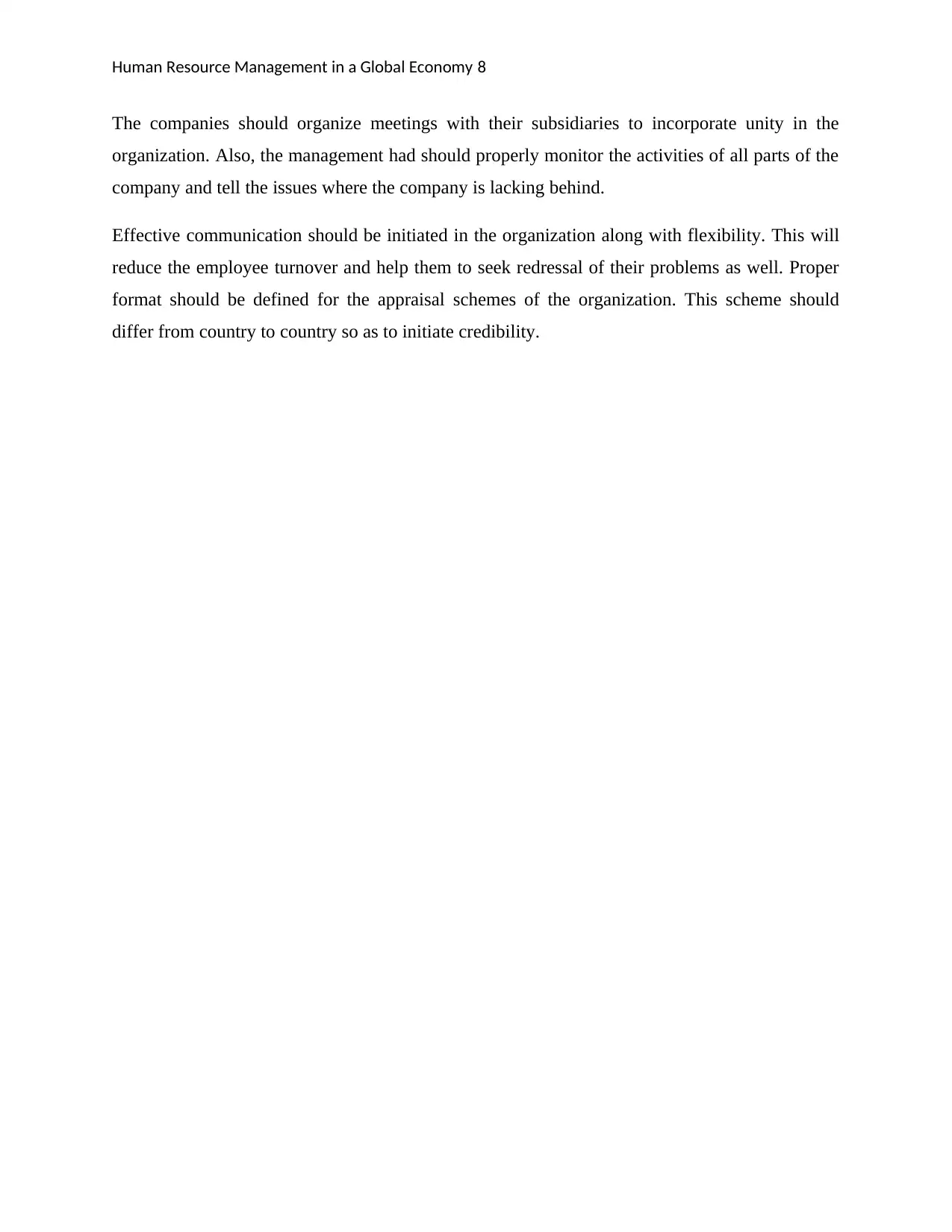
Human Resource Management in a Global Economy 8
The companies should organize meetings with their subsidiaries to incorporate unity in the
organization. Also, the management had should properly monitor the activities of all parts of the
company and tell the issues where the company is lacking behind.
Effective communication should be initiated in the organization along with flexibility. This will
reduce the employee turnover and help them to seek redressal of their problems as well. Proper
format should be defined for the appraisal schemes of the organization. This scheme should
differ from country to country so as to initiate credibility.
The companies should organize meetings with their subsidiaries to incorporate unity in the
organization. Also, the management had should properly monitor the activities of all parts of the
company and tell the issues where the company is lacking behind.
Effective communication should be initiated in the organization along with flexibility. This will
reduce the employee turnover and help them to seek redressal of their problems as well. Proper
format should be defined for the appraisal schemes of the organization. This scheme should
differ from country to country so as to initiate credibility.
⊘ This is a preview!⊘
Do you want full access?
Subscribe today to unlock all pages.

Trusted by 1+ million students worldwide
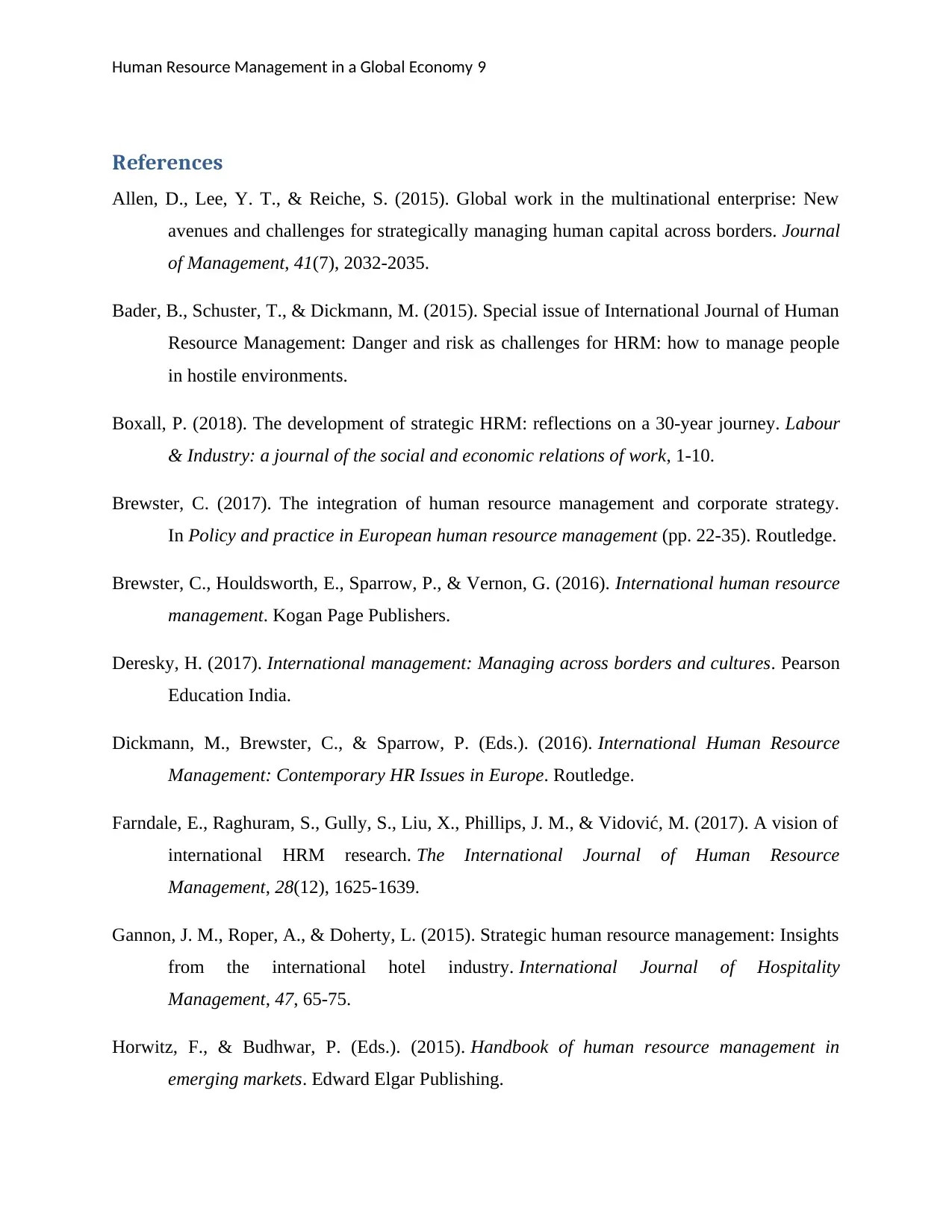
Human Resource Management in a Global Economy 9
References
Allen, D., Lee, Y. T., & Reiche, S. (2015). Global work in the multinational enterprise: New
avenues and challenges for strategically managing human capital across borders. Journal
of Management, 41(7), 2032-2035.
Bader, B., Schuster, T., & Dickmann, M. (2015). Special issue of International Journal of Human
Resource Management: Danger and risk as challenges for HRM: how to manage people
in hostile environments.
Boxall, P. (2018). The development of strategic HRM: reflections on a 30-year journey. Labour
& Industry: a journal of the social and economic relations of work, 1-10.
Brewster, C. (2017). The integration of human resource management and corporate strategy.
In Policy and practice in European human resource management (pp. 22-35). Routledge.
Brewster, C., Houldsworth, E., Sparrow, P., & Vernon, G. (2016). International human resource
management. Kogan Page Publishers.
Deresky, H. (2017). International management: Managing across borders and cultures. Pearson
Education India.
Dickmann, M., Brewster, C., & Sparrow, P. (Eds.). (2016). International Human Resource
Management: Contemporary HR Issues in Europe. Routledge.
Farndale, E., Raghuram, S., Gully, S., Liu, X., Phillips, J. M., & Vidović, M. (2017). A vision of
international HRM research. The International Journal of Human Resource
Management, 28(12), 1625-1639.
Gannon, J. M., Roper, A., & Doherty, L. (2015). Strategic human resource management: Insights
from the international hotel industry. International Journal of Hospitality
Management, 47, 65-75.
Horwitz, F., & Budhwar, P. (Eds.). (2015). Handbook of human resource management in
emerging markets. Edward Elgar Publishing.
References
Allen, D., Lee, Y. T., & Reiche, S. (2015). Global work in the multinational enterprise: New
avenues and challenges for strategically managing human capital across borders. Journal
of Management, 41(7), 2032-2035.
Bader, B., Schuster, T., & Dickmann, M. (2015). Special issue of International Journal of Human
Resource Management: Danger and risk as challenges for HRM: how to manage people
in hostile environments.
Boxall, P. (2018). The development of strategic HRM: reflections on a 30-year journey. Labour
& Industry: a journal of the social and economic relations of work, 1-10.
Brewster, C. (2017). The integration of human resource management and corporate strategy.
In Policy and practice in European human resource management (pp. 22-35). Routledge.
Brewster, C., Houldsworth, E., Sparrow, P., & Vernon, G. (2016). International human resource
management. Kogan Page Publishers.
Deresky, H. (2017). International management: Managing across borders and cultures. Pearson
Education India.
Dickmann, M., Brewster, C., & Sparrow, P. (Eds.). (2016). International Human Resource
Management: Contemporary HR Issues in Europe. Routledge.
Farndale, E., Raghuram, S., Gully, S., Liu, X., Phillips, J. M., & Vidović, M. (2017). A vision of
international HRM research. The International Journal of Human Resource
Management, 28(12), 1625-1639.
Gannon, J. M., Roper, A., & Doherty, L. (2015). Strategic human resource management: Insights
from the international hotel industry. International Journal of Hospitality
Management, 47, 65-75.
Horwitz, F., & Budhwar, P. (Eds.). (2015). Handbook of human resource management in
emerging markets. Edward Elgar Publishing.
Paraphrase This Document
Need a fresh take? Get an instant paraphrase of this document with our AI Paraphraser
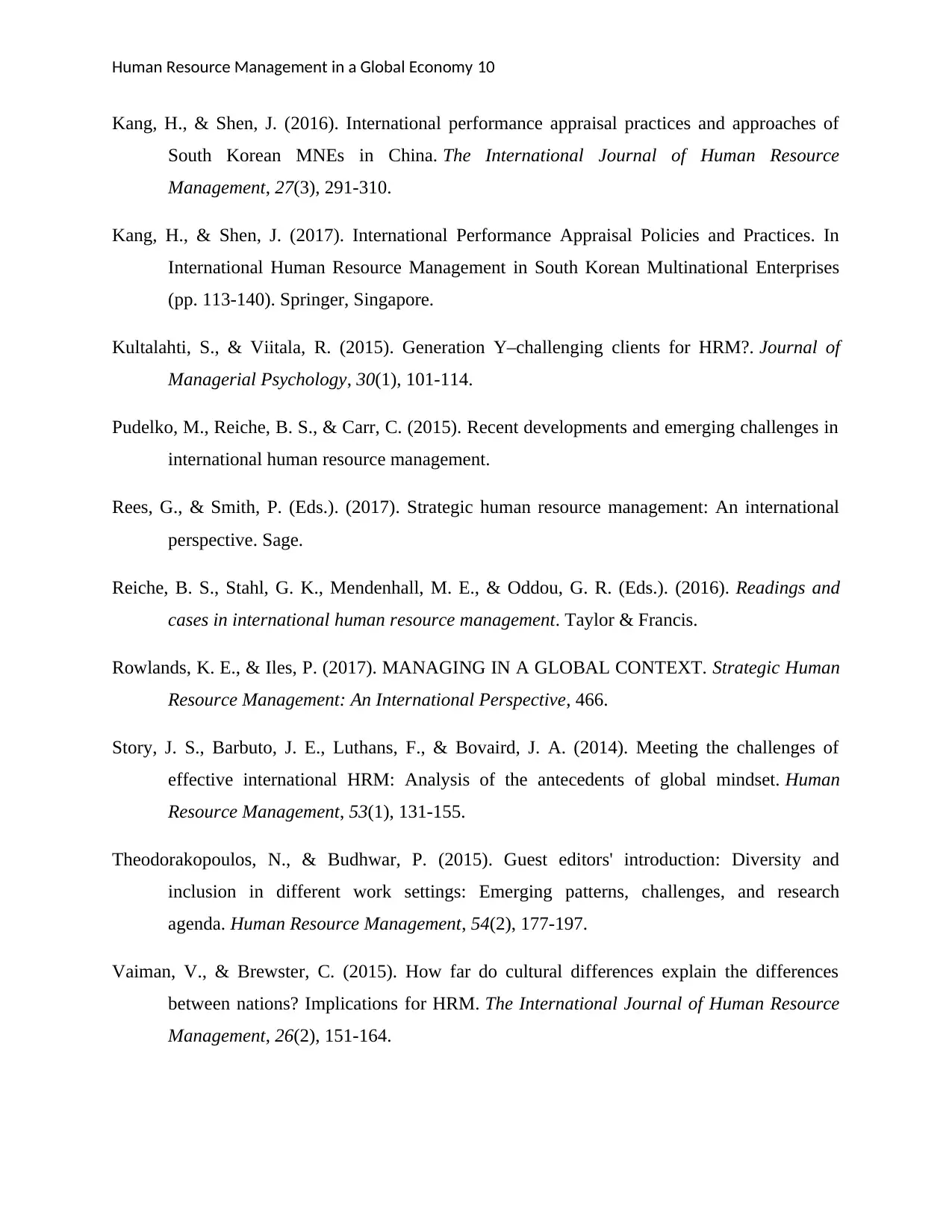
Human Resource Management in a Global Economy 10
Kang, H., & Shen, J. (2016). International performance appraisal practices and approaches of
South Korean MNEs in China. The International Journal of Human Resource
Management, 27(3), 291-310.
Kang, H., & Shen, J. (2017). International Performance Appraisal Policies and Practices. In
International Human Resource Management in South Korean Multinational Enterprises
(pp. 113-140). Springer, Singapore.
Kultalahti, S., & Viitala, R. (2015). Generation Y–challenging clients for HRM?. Journal of
Managerial Psychology, 30(1), 101-114.
Pudelko, M., Reiche, B. S., & Carr, C. (2015). Recent developments and emerging challenges in
international human resource management.
Rees, G., & Smith, P. (Eds.). (2017). Strategic human resource management: An international
perspective. Sage.
Reiche, B. S., Stahl, G. K., Mendenhall, M. E., & Oddou, G. R. (Eds.). (2016). Readings and
cases in international human resource management. Taylor & Francis.
Rowlands, K. E., & Iles, P. (2017). MANAGING IN A GLOBAL CONTEXT. Strategic Human
Resource Management: An International Perspective, 466.
Story, J. S., Barbuto, J. E., Luthans, F., & Bovaird, J. A. (2014). Meeting the challenges of
effective international HRM: Analysis of the antecedents of global mindset. Human
Resource Management, 53(1), 131-155.
Theodorakopoulos, N., & Budhwar, P. (2015). Guest editors' introduction: Diversity and
inclusion in different work settings: Emerging patterns, challenges, and research
agenda. Human Resource Management, 54(2), 177-197.
Vaiman, V., & Brewster, C. (2015). How far do cultural differences explain the differences
between nations? Implications for HRM. The International Journal of Human Resource
Management, 26(2), 151-164.
Kang, H., & Shen, J. (2016). International performance appraisal practices and approaches of
South Korean MNEs in China. The International Journal of Human Resource
Management, 27(3), 291-310.
Kang, H., & Shen, J. (2017). International Performance Appraisal Policies and Practices. In
International Human Resource Management in South Korean Multinational Enterprises
(pp. 113-140). Springer, Singapore.
Kultalahti, S., & Viitala, R. (2015). Generation Y–challenging clients for HRM?. Journal of
Managerial Psychology, 30(1), 101-114.
Pudelko, M., Reiche, B. S., & Carr, C. (2015). Recent developments and emerging challenges in
international human resource management.
Rees, G., & Smith, P. (Eds.). (2017). Strategic human resource management: An international
perspective. Sage.
Reiche, B. S., Stahl, G. K., Mendenhall, M. E., & Oddou, G. R. (Eds.). (2016). Readings and
cases in international human resource management. Taylor & Francis.
Rowlands, K. E., & Iles, P. (2017). MANAGING IN A GLOBAL CONTEXT. Strategic Human
Resource Management: An International Perspective, 466.
Story, J. S., Barbuto, J. E., Luthans, F., & Bovaird, J. A. (2014). Meeting the challenges of
effective international HRM: Analysis of the antecedents of global mindset. Human
Resource Management, 53(1), 131-155.
Theodorakopoulos, N., & Budhwar, P. (2015). Guest editors' introduction: Diversity and
inclusion in different work settings: Emerging patterns, challenges, and research
agenda. Human Resource Management, 54(2), 177-197.
Vaiman, V., & Brewster, C. (2015). How far do cultural differences explain the differences
between nations? Implications for HRM. The International Journal of Human Resource
Management, 26(2), 151-164.
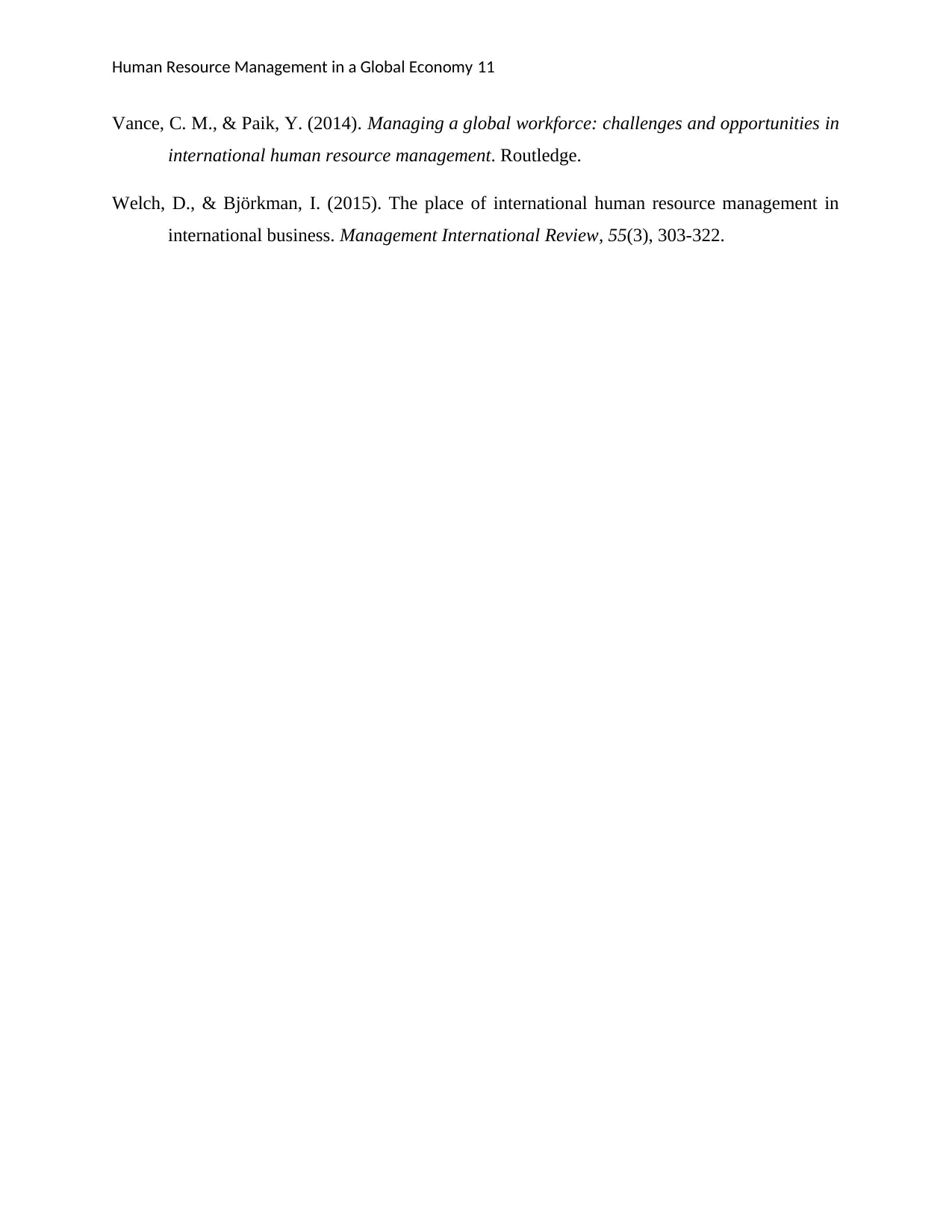
Human Resource Management in a Global Economy 11
Vance, C. M., & Paik, Y. (2014). Managing a global workforce: challenges and opportunities in
international human resource management. Routledge.
Welch, D., & Björkman, I. (2015). The place of international human resource management in
international business. Management International Review, 55(3), 303-322.
Vance, C. M., & Paik, Y. (2014). Managing a global workforce: challenges and opportunities in
international human resource management. Routledge.
Welch, D., & Björkman, I. (2015). The place of international human resource management in
international business. Management International Review, 55(3), 303-322.
⊘ This is a preview!⊘
Do you want full access?
Subscribe today to unlock all pages.

Trusted by 1+ million students worldwide
1 out of 12
Related Documents
Your All-in-One AI-Powered Toolkit for Academic Success.
+13062052269
info@desklib.com
Available 24*7 on WhatsApp / Email
![[object Object]](/_next/static/media/star-bottom.7253800d.svg)
Unlock your academic potential
Copyright © 2020–2025 A2Z Services. All Rights Reserved. Developed and managed by ZUCOL.




